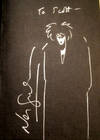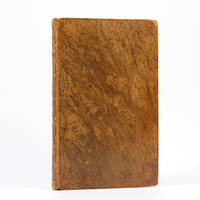
A Guide to the Rudolph Zallinger Mural The Age of Reptiles in the Peabody Museum, Yale University. Discovery Supplement Number 1.
by (Zallinger, Rudolph) Ostrom, John H. & Theodore Delevoryas
- Used
- Condition
- See description
- Seller
-
Moray, United Kingdom
Payment Methods Accepted
About This Item
New Haven, CT: Peabody Museum of Natural History, Yale University, 1966. 38-page pamphlet, wire-stitched. Original green wrappers printed in black. Folding plate depicting the mural and "Earth Clock". Pencilled number to the edge of the upper wrapper. A fine copy. Reissue of this illustrated visitor's guide to the magisterial Age of Reptiles mural in the Great Hall of Yale's Peabody Museum, written by John Ostrom, one of the most important palaeontologists of the 20th century. Originally published in 1966 in the same pamphlet form. A beautiful copy in unusually nice condition. "The Age of Reptiles mural is an artistic masterpiece and was, for its time, perhaps the most scientifically accurate representation of the Mesozoic world ever created" (Black, "Creating the Age of Reptiles", Smithsonian Magazine, January 3, 2012). The 110-foot-long, 16-foot-high mural was completed between 1943 and 1947 by art student Rudolph Zallinger (1919-1995), who had previously been employed at the museum painting seaweed specimens. Museum director Albert Parr had initially envisioned the space broken into panels illustrating individual species, but Zallinger developed the idea for a "sweep through time" from the Devonian period to the Cretaceous, "more than three million years of earth history" (introduction to the present). "With the format established, Zallinger was rapidly schooled in vertebrate paleontology, paleobotany and anatomy by the museum's experts. The animals had to be scientifically accurate, their environments appropriately stocked with plants from the right era, and the whole fossil cast had to fit together in an aesthetically pleasing style. Accuracy was of extreme importance, but so was making the painting visually appealing to visitors... The artist also faced the technical decision of how to execute the mural. Zallinger decided on a fresco secco, a classic method in which pigments are combined with egg and water and are painted on dried plaster that is moistened at the time of application. As Zallinger composed each successive rendition of the mural, the space he was going to paint on was prepared and covered in plaster. What is remarkable is how early Zallinger arrived at what became the final layout for his Mesozoic panorama. While the fine details of the plants and animals changed with each ever-more-detailed version, their general shapes and poses were established by the time Zallinger created a 1943 'cartoon' version of the mural on rag paper" (Black). The mural is one of the largest paintings in the world, and earned its creator a Pulitzer Fellowship in Art in 1949. It was highly influential in both paleontological art and in popular culture during the mid-century. A number of guides to the mural have been published over the years, including this one by John H. Ostrom (1928 - 2005). Ostrom was a Yale professor, director of the Peabody Museum, and "the most influential palaeontologist of the second half of the 20th century" (Dodson & Gingerich, "John H. Ostrom", American Journal of Science, volume 306, number 1, January 2006). He discovered that dinosaurs had the metabolisms and agility of mammals and birds, and that they were closely related to modern birds, leading to the "dinosaur renaissance" of the second half of the century.
Reviews
(Log in or Create an Account first!)
Details
- Bookseller
- Alembic Rare Books
(GB)
- Bookseller's Inventory #
- 708
- Title
- A Guide to the Rudolph Zallinger Mural The Age of Reptiles in the Peabody Museum, Yale University. Discovery Supplement Number 1.
- Author
- (Zallinger, Rudolph) Ostrom, John H. & Theodore Delevoryas
- Book Condition
- Used
- Quantity Available
- 1
- Publisher
- Peabody Museum of Natural History, Yale University
- Place of Publication
- New Haven, CT
- Date Published
- 1966
- Weight
- 0.00 lbs
- Keywords
- Biology|Natural History|Zoology|Dinosaurs|Popular Science
Terms of Sale
Alembic Rare Books
30 day return guarantee, with full refund including original shipping costs for up to 30 days after delivery if an item arrives misdescribed or damaged.
About the Seller
Alembic Rare Books
Biblio member since 2018
Moray
About Alembic Rare Books
We specialise in rare science books dating from the late Middle Ages to the 20th century, including first editions, signed copies, manuscripts, objects, and ephemera. We have particular expertise in natural history, genetics and evolution, anatomy, nuclear physics and the Manhattan Project, early computing, and women in science. We also carry books related to women's history and literature.
Glossary
Some terminology that may be used in this description includes:
- Plate
- Full page illustration or photograph. Plates are printed separately from the text of the book, and bound in at production. I.e.,...
- Wrappers
- The paper covering on the outside of a paperback. Also see the entry for pictorial wraps, color illustrated coverings for...
- Fine
- A book in fine condition exhibits no flaws. A fine condition book closely approaches As New condition, but may lack the...
This Book’s Categories
Also Recommended
-

Save 10% on every purchase!
Join the Bibliophiles’ Club and start saving 10% on every book.
$29.95 / Year










![Vergleichende Anatomie der Wirbeltiere: Rana esculenta. Wasserfrosch. [Comparative Anatomy of the Vertebrates: Rana esculenta. Water Frog.]](https://d3525k1ryd2155.cloudfront.net/h/084/470/1174470084.0.m.jpg)
![Vergleichende Anatomie der Wirbeltiere: Die Zauneidechse. Lacerta agilis. [Comparative Anatomy of the Vertebrates: Sand Lizard. Lacerta agilis.]](https://d3525k1ryd2155.cloudfront.net/h/108/470/1174470108.0.m.jpg)
